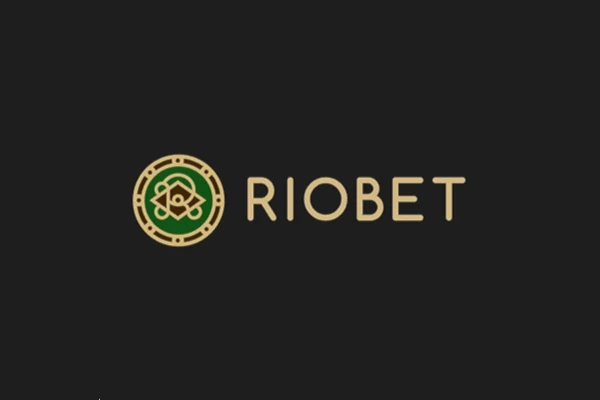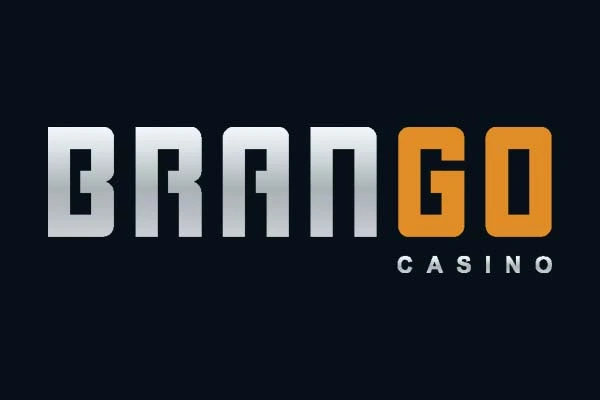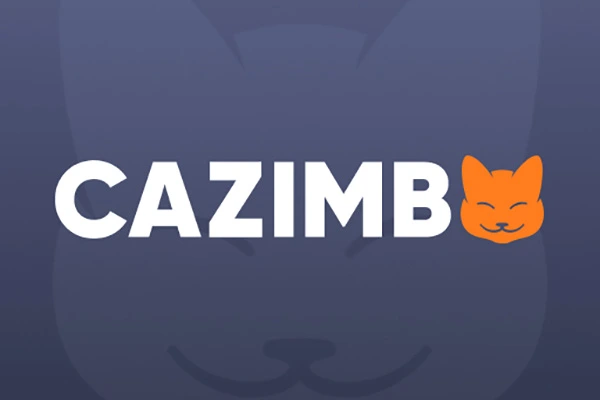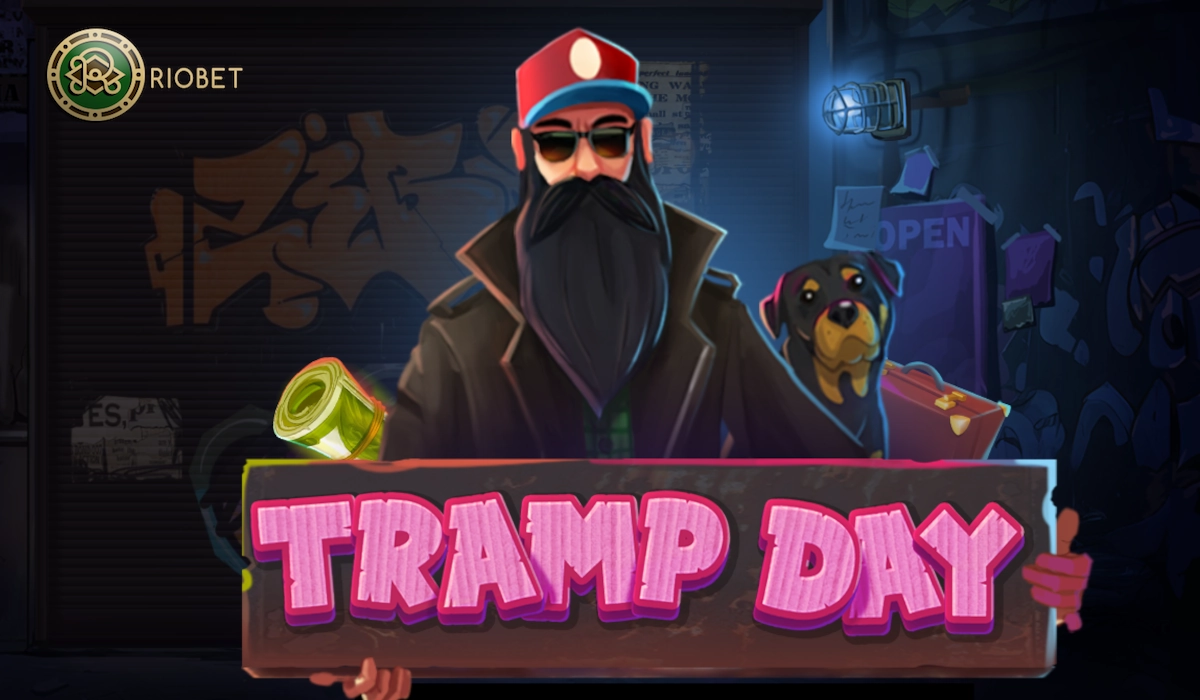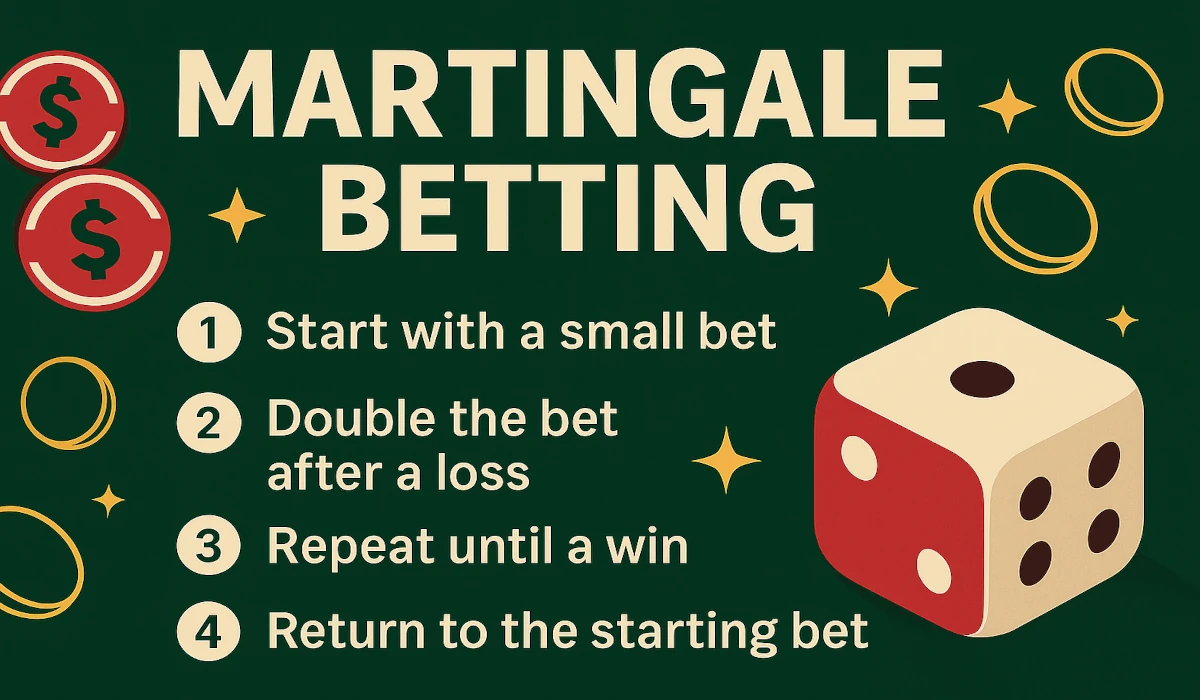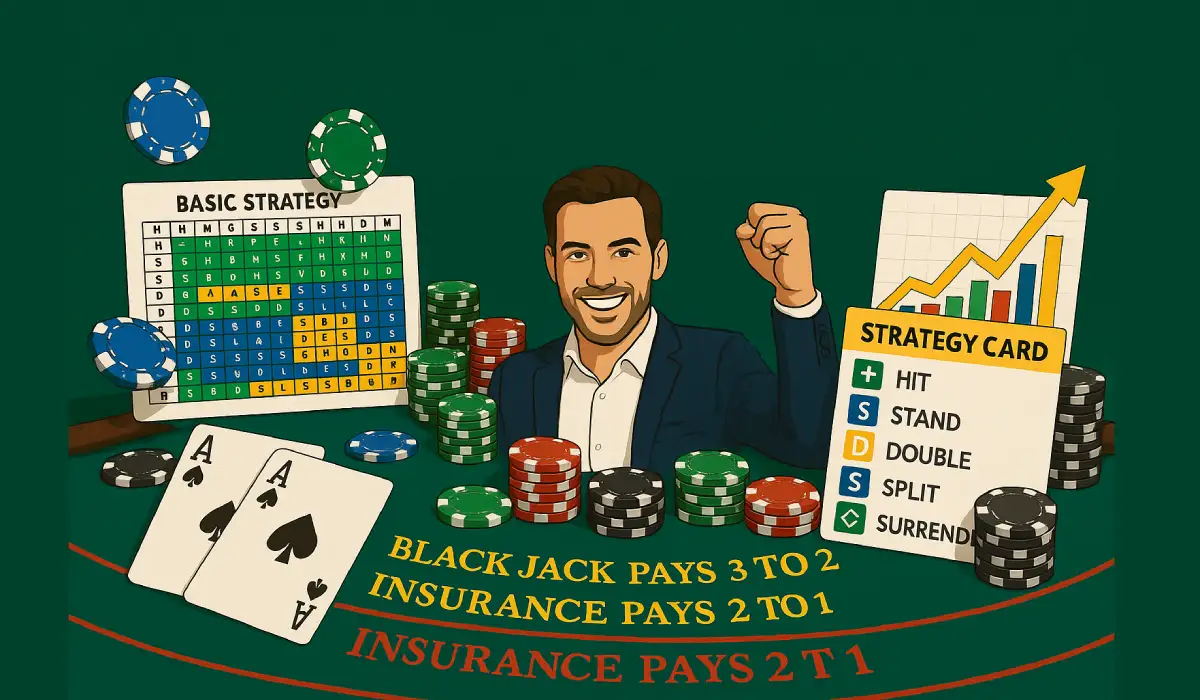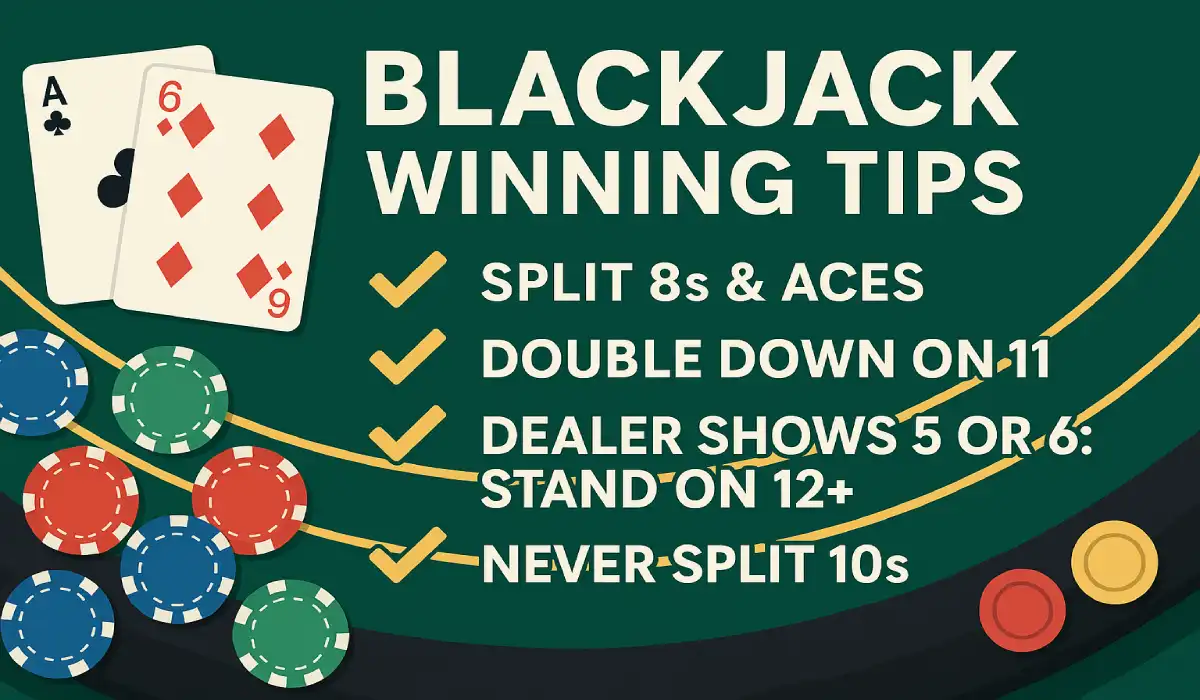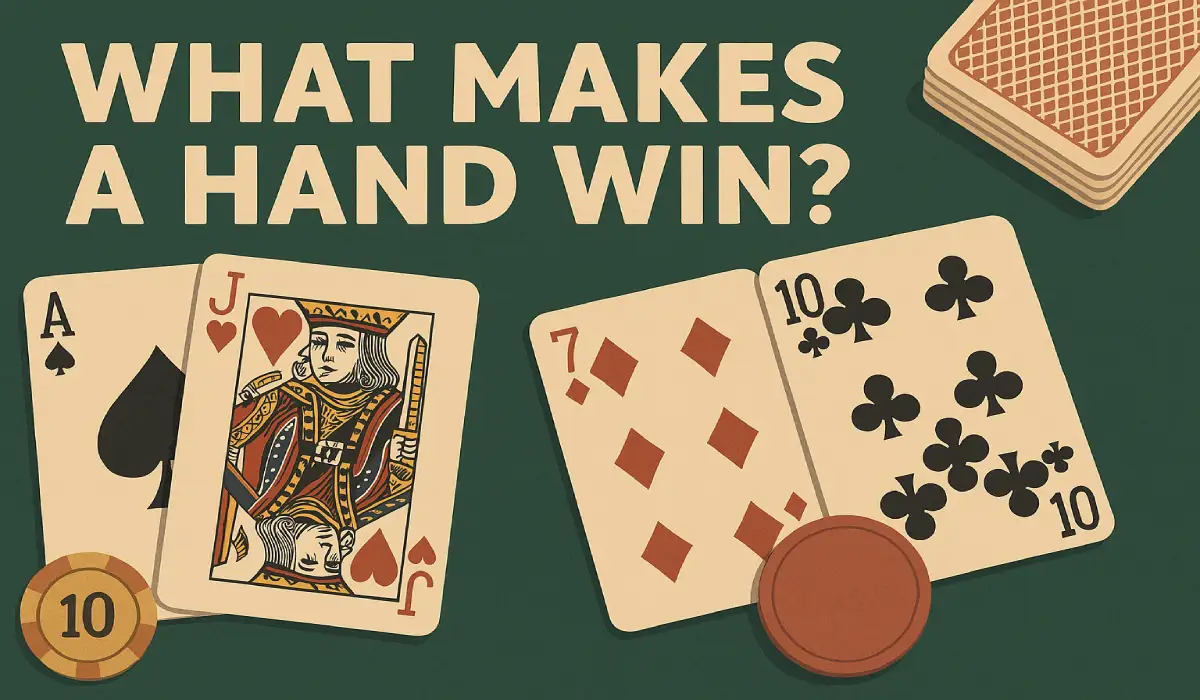
03 Jul 2025
Understanding Blackjack Hands: How to Identify and Play Them
🗝️ Key Takeaways
- Knowing the difference between hard and soft hands is key and is where optimal player strategies differ.
- Knowing the worth of a natural blackjack and the payout edges that it provides can make all the difference for both players in the moment and over time.
- There are optimal times to hit, stand, double, or split depending on your hand total and the dealer's visible card.
- Adjusting for deck rules and house variations — like single deck, multi-deck, or soft 17 rules — is an important step in keeping the odds in your favor and your play fine-tuned.
- By sidestepping the usual suspects, like insurance bets and splitting tens, it minimizes your hidden exposure and backs a more math-friendly strategy.
- By keeping careful track of the dealer's upcard and the bust probabilities, players can make smarter decisions during each hand.
♠️ Defining Blackjack Hands
Cracking the code of hard, soft, and natural blackjack hands opens the door to smarter decisions and more incisive play. The value of each card and how hands are constructed determine risk and reward.
The game recognizes three main categories: action hands (2–11), bust hands (12–16), and made hands (17+). Each carries its own decisions and dangers.
💪 Hard Hands
Hard hands require more disciplined decision-making. With totals between 12 and 16, the risk of busting is high, but you often have to take that chance if the dealer shows a strong upcard.- Stand on hard 17+, regardless of the dealer’s card.
- If hard, 12–16, and the dealer has 7 or more - Hit.
- Always hit hard totals of 8 or lower.
- Double hard 10 or 11 if the dealer’s card is weak.
🪶 Soft Hands
Soft hands let you be more aggressive. Because the Ace can flip from 11 to 1, you can often hit or double down without fear of busting.🍀 Natural Blackjack
A natural is when your first two cards are an Ace + 10, J, Q, or K—21. These are the most valuable blackjack hands, and they beat every other hand except for another natural blackjack.
The payout is usually 3:2, which is higher than a standard win.
Getting a natural blackjack gives you an instant advantage. It pays higher, ends the round quickly and can’t be defeated, aside from another natural blackjack.
Those hands are so infrequent that it’s a premium event.
- Confirm the payout (usually 3:2) with the dealer.
- Avoid taking extra cards; stand immediately.
- If the dealer has a blackjack, it’s a ‘push’ or tie.
- Do not split a natural blackjack.
🏆 What Makes a Hand Win?
A winning blackjack hand is one that totals closer to 21 than the dealer without going over. It rewards thoughtful play and a knack for hand values.
Knowing what separates a winning hand from a losing hand is the secret to crafting strategies and understanding the blackjack terms and terminologies that bring the house edge down, on average, to under 1%.
| Winning Hand Features | Losing Hand Features |
| Closest to 21, not over | Busts (over 21) |
| Natural (Ace + 10) | Lower than dealer’s hand |
| Dealer busts | Dealer has 21 |
| Strategic doubles/splits | Poor play decisions |
1. The Natural
A "natural blackjack" happens when you have an Ace paired with any 10-value card, making it the most powerful opening hand. It pays out at 3:2 in most casinos, making it more profitable than a regular win.
If a player has a natural, the dealer can only push by having one as well. Otherwise, it’s an immediate win for the player.
This result is uncommon, happening in approximately 4.8% of hands, yet it influences dealer and player behavior. The attraction of the natural, with its instant win and superior payout, is part of what makes blackjack so attractive.
2. The Strong Stand
Standing means keeping your current hand, wishing the dealer busts or falls short of your total. A strong stand typically means totals of 17 or more or two tens—a hand that wins almost 80% of the time.
When the dealer has a weak upcard (like 4, 5, or 6), standing on a stout hand jams the dealer into desperate draws. The idea is not to be reckless when you already have a winning total.
Remember to consider the dealer’s upcard — standing on a hard 16 against a dealer’s 6, for instance, beats hitting.
3. The Dealer Bust
Dealer busting — going over 21 — often means a win for players who stay in. Players can reduce bust potential by standing on lower totals when the dealer has a weak card (2, 3, 4, 5, or 6).
Aggressive play is more risky than weak dealer cards if the upcard is strong (7 to Ace). Soft hands such as A,2 (soft 13) should be doubled down, particularly against dealer 5 or 6.
This maximizes the opportunity to capitalize on dealer errors.
4. The Strategic Double
Doubling down gives you the possibility to double your wager for one extra card, which can have greater benefits when employed correctly. It’s best with totals of 9, 10, or 11, particularly vs. weak dealer cards (2-9).
For instance, 5’s should double if the dealer shows 2–9. Though doubling increases the risk, the payoff is greater if you pull a power card.
Follow standard guidelines: double soft 13 (A,2) against dealer 5 or 6, not otherwise.
5. The Advantageous Split
When you split a pair, you’re essentially giving yourself two hands that could win. Not all pairs should split: always split 8’s and Aces, but avoid splitting tens or fives.
Splitting 4’s is logical solely versus dealers 5 and 6. Splitting is risky and complicated, so control each hand with care. Consider the dealer’s upcard when deciding on splits.
♟️ Core Strategic Actions
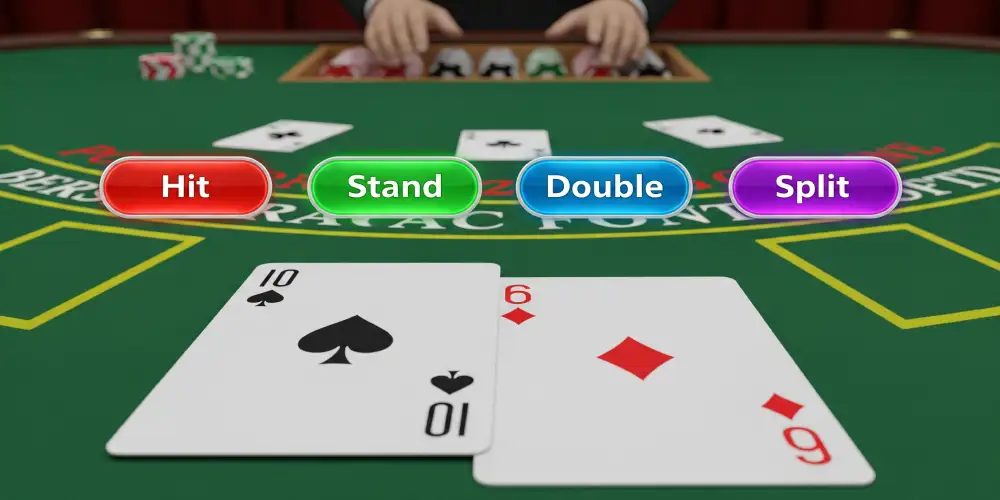
Blackjack is built around four main choices: hit, stand, double, and split. Knowing when to use each can change the odds and reduce the house's advantage.
These moves, each with their own gambles and payoffs, are the building blocks of a solid blackjack strategy guide. Expertise takes into consideration hand value, dealer upcard, and game dynamics.
- Hit
- Stand
- Double
- Split
🎯 When to Hit
To hit is to request another card. Hit when your hand is weak—usually 12 or below—or the dealer’s upcard is strong.
For instance, if you’re dealt a hard 13 and the dealer displays a 7 or higher, hitting is optimal. Hit soft 13 (Ace and 2) unless the dealer has 5 or 6, then double.
The primary danger is busting, particularly with hand value increases. To reduce this hazard, heed if your hand is hard (no Ace) or soft (one Ace counted as 11).
✋ When to Stand
Hit if you’re good to stand on strong hands or bust-ey in the dealer’s hand. For hard 13 or hard 15, stand if the dealer has 2 through 6.
This is because the dealer bust chance is higher with low upcards. Solid totals such as 17 or greater should pretty much always hold. Many players make the mistake of standing on soft hands under 18—this frequently surrenders value.
A careful read of both your hand and the dealer’s upcard keeps these mistakes at bay.
✌️ When to Double
Doubling down means you have the opportunity to double your bet for one more card. Your optimal double down is when you’re nitro-fueled with a solid starting hand—like 9, 10, or 11, and the dealer exhibits a vulnerable upcard (2–9).
5,5– double against dealer 2-9 soft 13 (Ace-2) vs dealer 5 or 6 – double is best. Upscale strategies even recommend doubling on soft 19–20 and hard 8 or 7 occasionally.
Doubling can supercharge returns but raises risk if not carefully timed.
✂️ When to Split
Splitting is for couples. Always split Aces and 8s, but split 4s only against dealers 5 and 6.
Splitting can transform a weak hand into two strong ones, but bad decisions—such as splitting 10s—do more harm than good. Once you split, play each hand on its own, and be aware of the guidelines for doubling or re-splitting.
Don’t split unless the blackjack math is in your favor, like with low dealer upcards.
🔍 Reading the Dealer's Hand
Knowing how to read the dealer's hand is at the heart of intelligent blackjack strategy. Using a cheat sheet can help players understand the dealer's upcard, which provides information about hazards and how to play each hand.
Unlike players, dealers play by house rules—generally they hit on soft 17, stand on hard 17, and never gamble or pull decisions from whim. Since the upcard is always face up, it's the primary hint to choose the correct action—hit, stand, double down, or split.
This is true at every table, even those where the hole card remains concealed until the end, such as in most European casinos.
🔝 Strong Upcards
A dealer's strong upcard is a 7, 8, 9, 10 or ace. These cards provide the dealer with a better opportunity to hit a strong hand, typically 17 or above.
When the dealer has a strong upcard, players need to be cautious about betting. The odds are stacked against praying for a dealer bust, so play defense—stand on lighter hands, never double down unless your own hand is strong, and don't split pairs unless the numbers support it.
Powerful upcards compel you to check-raise. Take, for instance, having 16 vs. A dealer's 10 — the right answer is almost always to hit, despite the fact that you could bust.
With 12 versus a dealer 2 or 3, standing is less safe since the dealer's probability of producing 17 or higher is high. Knowing about a powerful upcard early allows you to avoid expensive errors and stay with a solid strategy.
⚠️ Weak Upcards
2-6 are weak upcards for the dealer. They positioned the dealer at a greater risk of busting if compelled to hit until 17.
Players can take advantage of this, typically standing on much lower totals like 12 or 13, and doubling down more frequently on 9, 10 or 11.
Because the bust rate for the dealer spikes, players should double down with 10 or 11 against a dealer 5 or 6. Splitting 2s, 3s, or 6s, though, is almost always a smart move versus weak upcards.
The initial card—dealt, as always, from the dealer's left, first base—tempo up the round and frames your decisions. Dealer bust odds are significantly greater with feeble upcards.
In select games, side bets even allow you to bet on the dealer busting with a given upcard. This is only possible because the upcard provides so much information.
💥 Dealer Bust Probabilities
Dealer busts are highest when showing a 4, 5, or 6, with bust rates of 40% or higher. That's why most strategy cards tell you to stand on 12 or higher against a dealer's 6.
This impact is even more acute in "no hole card" games, as the dealer's hand isn't finalized until every player has acted. Focusing on these odds provides players with a distinct advantage.
Upcard reading is not conjecture—it's fundamental to basic strategy.
🧙♂️ The Myth of "Safe" Bets
Several players assume that certain blackjack bets are safe, but this notion is deceiving. Because of the nature of chance, no bet is truly safe, even if it appears savvy or is supported by previous victories.
Betting systems or a hot hand, after all, are a comforting illusion and can encourage gamblers to make poor risk-based decisions.
🔒 The Insurance Trap
Insurance is a side bet when the dealer's up card is an Ace. It allows players to wager up to ½ their initial wager, anticipating the dealer is given a down-facing ten card and having a blackjack.
If the dealer does, insurance pays 2:1, but if not, the insurance bet is lost.
Most pundits concur that blackjack insurance is a lousy bet. Those odds are almost never in the player's favor.
There are just 16 ten-value cards in a deck of 52, so the probability the dealer's got blackjack is less than one in three. Yet, insurance leeches more from players over time than it pays back.
Rather than taking insurance, players are better off adhering to basic blackjack strategy. This trims the house edge and sidesteps the premium du jour of side bets.
When you play consistently and informed, you do better in the long run than when you're chasing a safety feeling.
❌ The Ten-Splitting Fallacy
One of the biggest blunders is breaking up a pair of tens, assuming two hands increase your odds to cash. In fact, twenty is among the strongest hands possible in blackjack.
When splitting tens, card counters dismantle a close-to-guaranteed winner for the hope of two inferior wagers. For instance, if you have two tens and split them, you might wind up with two hands of twelve or thirteen — definitely a lot easier for the dealer to trounce.
This frequently converts a firm standing into an expensive mistake.
Knowing when a twenty hand is golden is the trick. It can't be enhanced by splitting, and it places the player in a commanding position against almost all dealer upcards.
📜 How Deck Rules Change Hands
Deck rules influence how blackjack hands unfold, varying not only the statistics of each deal but also player strategies. As casinos change deck counts and dealer rules, the odds and strategies adapt, keeping the game fresh and challenging for advantage players.
How many decks, what the doubling or splitting policy is and if the dealer stands or hits on soft 17 all counts. Even tiny rule tweaks can shift the house edge by quantifiable margins, as demonstrated in the following table.
| Deck Rule/Change | House Edge Impact | Player Strategy Impact |
| Single deck | -0.563% vs 8 decks | Favors card counters |
| Eight decks | Baseline | Fewer blackjack wins |
| No doubling after split | +0.12% | Reduces aggressive play |
| Dealer stands on soft 17 (Reno) | +0.1% | Adjust stand/hit choices |
| Dealer stands on soft 17 (Europe) | +0.2% | More cautious play |
🎲 Single Deck Odds
Single-deck blackjack has an even lower house edge, with the player’s return about -0.012%. The chance of getting a natural blackjack increases from 4.527% to 4.649% in eight-deck games.
This seemingly minor tweak results in more frequent payouts at the topmost odds, which adds up to a player’s total winnings over time.
Players have to change their strategy. With fewer cards, fundamental strategy changes–particularly with doubling and splitting.
Card counting gets much simpler, since keeping tabs on one deck is more manageable. Casinos are aware of this, so single-deck games tend to be more strict in other areas–like blackjack paying less.
🃏 Multi-Deck Odds
Multi-deck blackjack, with six or eight decks, is now the standard in most casinos. This format reduces the chances of getting blackjack and escalates the house edge, approaching -0.575% for players.
Card counting doesn’t work as well because the deck is so big.
Strategic play gets more hard-and-fast, and the advantage of doubling or splitting wanes. Casinos often don’t allow doubling after splits, which increases the house edge by 0.12%.
These games tend to attract casual players as the apparent complexity deters advanced play.
✋ Soft 17 Rules
A soft 17 is any hand where the ace counts as 11, for example, an ace-six. Certain casinos have dealers hit on soft 17, some to stand.
The Reno rule (dealer stands) bumps the house edge by 0.1% — in Europe, this can be as high as 0.2%. These nuances imply that players ought to adjust strategy — standing more when dealers have to hit, and pushing the envelope when they stand.
🔒 Conclusion
Both blackjack hands display skill, nerve, and a little bit of luck. Hands are a new beginning. Smart players observe the dealer, calculate their possibilities, and move quickly.
Clever plays arise from straightforward principles and clear attention, not hunches. Little things like deck changes or table rules cause huge shifts in play.
No wager sits secure long. Only clean decisions and calm brains produce true victories.
To develop strategy, test out fresh hands, log your moves, and analyze every round. Be alert and believe your instincts.
The advantage belongs to the observant simplicity seekers.
Frequently Asked Questions❓
What is a blackjack hand?
A blackjack hand is the combination of cards that a player or dealer holds in a round. Your objective is to get as close to 21 as possible without exceeding it.
How does a hand win in blackjack?
A hand wins if it is closer to 21 than the dealer’s hand, without breaking 21. Any hand over 21 is an automatic loss.
What are the main actions a player can take in blackjack?
Players can hit (take another card), stand (keep current cards), double down (double bet and take one more card), or split (separate two same-value cards into two hands).
Why is the dealer's hand important?
The dealer’s upcard allows players to determine their plays. Knowing the dealer’s card can help you decide what to hit, stand, or otherwise.
Are there truly "safe" bets in blackjack?
No bet in blackjack is safe. Each hand is dangerous. Savvy play and knowledge of the probabilities do aid, but there’s no sure-fire way to win always.
How do deck rules affect blackjack hands?
Depending on the number of decks and house rules, odds can shift. For instance, more decks typically reduce the player’s odds.
What happens if both the player and dealer have the same hand value?
If the player and dealer tie with the same hand value, it’s a ‘push’. For example, in this instance the player gets his original bet back.
